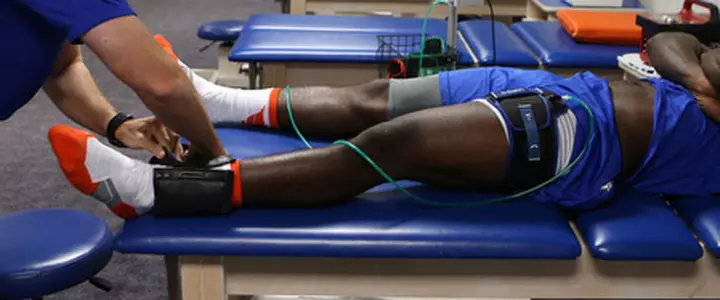
Gators Using Advanced Military Technique to Rehab Injured Players
Thursday, August 27, 2015 | Football, Scott Carter
GAINESVILLE, Fla. – Paul Silvestri grabs the machine and rolls it next to the training table where the player is resting on his stomach. He straps the large wrap that looks similar to a blood pressure cuff around the injured player's left leg.
Silvestri, the University of Florida football team's associate director of sports health, is treating a player who is unable to practice due to his leg injury. Once the cuff is in place, Silvestri turns on the machine to detect proper measurements before it squeezes off blood flow.
After blood flow is restricted to the muscle, the workout begins.
“We can get him going right away,'' Silvestri says. “There is nothing out there that allows him to get his work in like this.”
In the high-tech medical world of 2015, the machine is called a personalized tourniquet system (PTS) used for blood-flow restriction (BFR) therapy. The procedure is often referred to in layman's terms as “tourniquet training,” an emerging practice that uses blood-flow restriction to help athletes recover quicker from injury.
The University of Florida is the first school in the country to begin the use of BFR therapy to treat athletic injuries in conjunction with Johnny Owens, considered a pioneer in the field.
Owens is an expert in BFR training and the person who introduced Silvestri to the method, which applies a pneumatic surgical tourniquet to the injured limb to restrict blood flow while the patient engages in strength training at a very low resistance.

In its short history of use in America, BFR therapy has produced results that have caught the attention of the medical community and made Owens, who is also clinical director of Owens Recovery Science, in high demand.
At the invitation of Matthew Matava, team physician for the St. Louis Rams and head of the NFL Team Physicians Society, Owens attended the NFL Combine in April to speak to NFL teams after Owens helped teach the Houston Texans BFR training last fall.
The Texans' doctors used the treatment on defensive lineman Jadeveon Clowney, the No. 1 overall pick in the 2014 NFL Draft, with positive results to help Clowney recover from a pair of knee surgeries last season.
“The most beneficial aspect of this technique may be the ability to improve muscle strength while avoiding the stress of high-resistance exercise in the early phases of rehabilitation,'' Matava told ESPN.com.
While individual results vary, according to an ESPN.com story, patients have achieved an average of 50 to 80 percent strength gains using BFR therapy in as little as a few weeks.
While at the NFL combine earlier this year, Gators team physician Kevin Farmer met Owens to discuss BFR therapy and gather more information on what could be a revolutionary change in the way athletes rehabilitate muscle injuries. The Gators followed up and Owens traveled to UF recently to train the Gators' medical staff on the procedure.
Owens has spent more than a decade researching the method and later, applying BFR therapy to help wounded U.S. soldiers recover from blast-trauma injuries in his role as research physical therapist for San Antonio Military Medical Center/Center for the Intrepid in Texas.
“It is an amazing place,'' Owens said. “It's like the Disney World of rehab centers.”
Nearly all of the wounded warriors Owens helped treat faced the loss of a limb if unable to rehab.
“We were having a hard time getting these guys strong enough, with these compromised limbs from the war, we were really just looking for any other methods that were out there that were maybe missing,'' he said. “We kept coming across this [BFR] in the literature. It has been around for a while.”
According to Owens, approximately 350 “limb savages” – the team the Center for the Intrepid uses for patients fighting to save their limbs – have undergone the procedure at the rehab center.
After a decade of research and use in clinical trials, Owens is convinced the sports world will embrace the procedure.
“The strength gains we have seen from this has saved limbs,” he said. “The science has kind of been there since the '80s and '90s in physiology studies. The Japanese kind of took it and started working with it. That is kind of where it has been.
“Then some higher-tier [medical] publications –what we call impact-factor journals – started coming out with some research in the better labs and that's really what got my attention and sold it to the military.”
Owens was featured for his work by Hannah Storm of ESPN for a Veteran's Day special. But when the Texans called to investigate whether the treatment would work on Clowney, the door into high-performance athletics was opened.
Owens is currently working with 12 NBA and NFL teams on BFR therapy.
The ability to train using minimum weight soon after an injury is why BFR therapy could have a major place in the future of sports rehabilitation. Athletes recovering from injuries such as hamstring pulls and torn ACLs could return to action much sooner and avoid major atrophy in the injured area.
“The science is extremely solid on it,” Owens said. “We have reviewed it extensively. The clinical applications seem endless.”
Back inside the Gators' training room, Silvestri monitors the Florida player doing leg exercises with the PTS wrapped around his injured leg. The player strains as if trying to lift much greater weight than the five pounds wrapped around his ankle.
The blood-flow restrictive therapy is doing its job.
“He will feel like he went through a one-hour workout in five minutes,'' Silvestri says. “There is a lot of science behind this. The results back it up.”



